#petaloid
Text

.。*♡° Happy Pride Month From Crowds That Go Around And Say WoW From The UnderGround *♡°.。
.。*✧YaY YaY✧*.。
#animal crossing new horizons#acnh#pride month#June 13#Either an unlucky or a lucky number either which way I feel a little lucky ducky today#I like to make a acnh pic for every June#lesbian pride#lesbian#ac geodes#Should I name them all#xylophoid#tremoloid#twangoid#wallopoid#tockoid#thwopoid#petaloid#flutteroid#clatteroid#dootoid#aluminoid#ringoid#bwongoid#scatteroid#rattloid#oinkoid#bubbloid#... I hope I got all of them ...#At least in this pic#They are the crowd From The underground
4 notes
·
View notes
Text
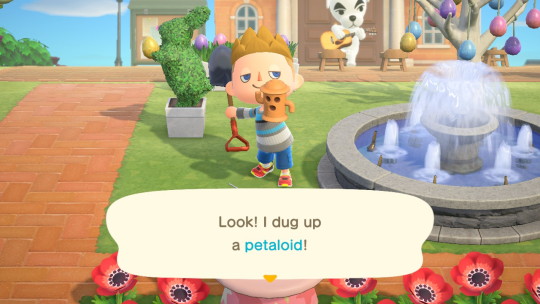
Another Petaloid?!
3 notes
·
View notes
Text
EO2 is really funny with the choice to make FOEs give zero EXP to solidify them as obstacles to avoid while also making them quest targets and creating some that do not move during certain times. In the game where you have to retire THIRTY times to reach max. And by funny I mean mind bogglingly evil
#what WERE they cooking. you think whacking Petaloids all day is peak gaming or something?#did any of the devs actually play this and get all the way to max. I'm just curious#etrian odyssey#eo2#lily.exe
31 notes
·
View notes
Photo

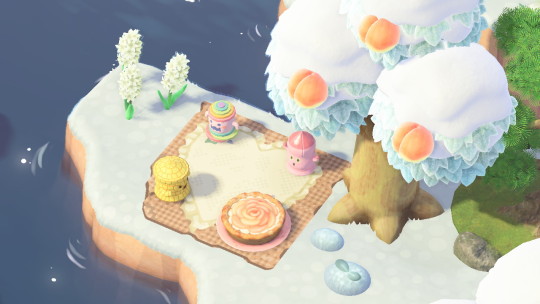
little gyroid picnic, what are you bringing? 🍑
#animal crossing#acnh#acnh gyroid#acnh exterior#acnh inspo#acnh petaloid#acnh squeezoid#acnh clatteroid#animal crossing gyroids#game#meworangeade
127 notes
·
View notes
Text
Please Animal Crossing what does it take to get a stinking Petaloid D:
#sunshine.txt#i've been gyroid hunting and stuff since they were added and in all that time the petaloid is the only one that i have NEVER FOUND
1 note
·
View note
Text
Sunny Leone Loves HD Porn Lexi Belle
Japanese Teen Naked Yoga with Perfect Tits
No mercy for salma booty
Sophie Dee Puma Swede Shower Time! HUGE Tits & So Sexy!
Tiny Babe Has Tight Pussy Stuffed By Hard Dick Bro
me encanta coger con mi chaparrita
my brother with big cock fucks my cheating german girlfriend with cumshot on her pussy
Skinny blonde teen big dick Analmal Training
Horny lady with big tits and ass fucks hard
Alluring amateur sweetheart takes cock doggy style has it deep
#wagonette#set-up#presumptious#Corwith#oilcamp#petaloideous#fly-net#macroseptum#missa#gears#favosite#chalets#stealingly#rinneite#longleg#Deipyle#distractile#pasion#conglobate#standardised
0 notes
Text
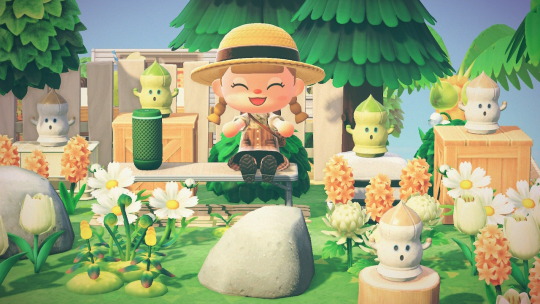

my spring gyroid garden🌱 another area i think i’d like to change up seasonally🌼 i went for neutral colors for spring, and the petaloid gyroid for a garden look🍃
#nordsea forever island💛#acnh#animal crossing#animal crossing new horizons#new horizons#acnh island#acnh exterior#acnh garden#acnh gyroids#acnh gyroid garden#acnh spring
141 notes
·
View notes
Text
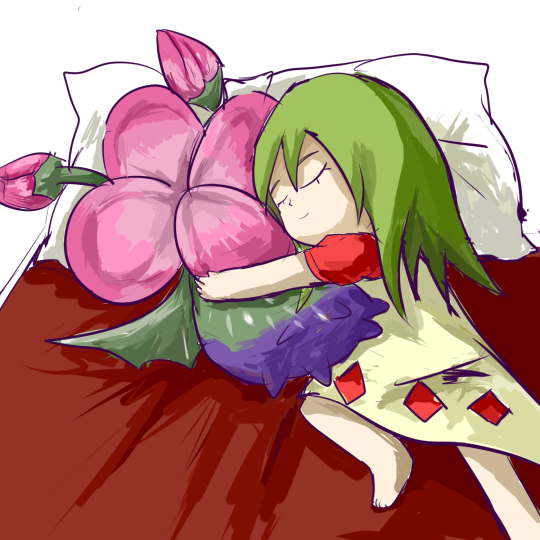
危険な花びら 抱き枕
安らかな眠り
Petaloid pillow
8 notes
·
View notes
Text
How to Identify Late Oyster Mushrooms
Click here to learn more about the How to Identify article series.
Name: Late oyster mushrooms (Sarcomyxa serotina)
Range and typical habitat(s): North American west, United States east of the Great Plains, widespread across Europe, extreme east Asia
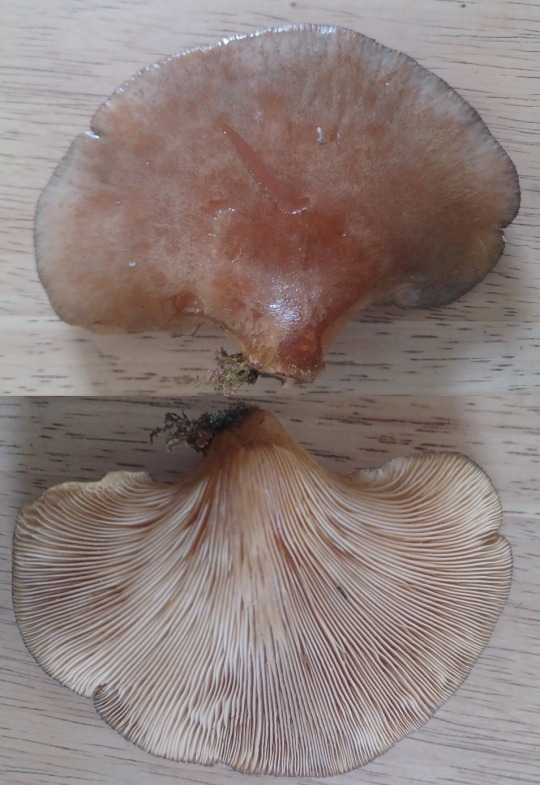
The top and underside of a late oyster mushroom.
Distinguishing physical characteristics (size, colors, overall shapes, detail shapes): At first glance the this looks like any other oyster mushroom, with its round, shelf-shaped appearance. However, where true oysters (Pleurotus spp.) tend to be gray or white in appearance, the slimy-textured cap of the late oyster can be anywhere from orange to olive-green to violet-tinted, and can grow up to six inches across. The gills are usually yellow to orange, and while some may remain single from the stipe to the edge of the cap, others fork at least once.
Young late oyster mushrooms may have edges that roll under, but when mature they open to a flatter shape, sometimes with a gently scalloped edge. The stipe is quite unique with its fuzzy texture, and is generally very short. The tightly-packed gills are adnate, meaning that they attach to the stipe with their entire width, rather than becoming shorter in height as they approach the stipe. Take a spore print of a late oyster mushroom, and you’ll find a cream to yellow print. The flesh does not bruise or otherwise discolor when damaged.
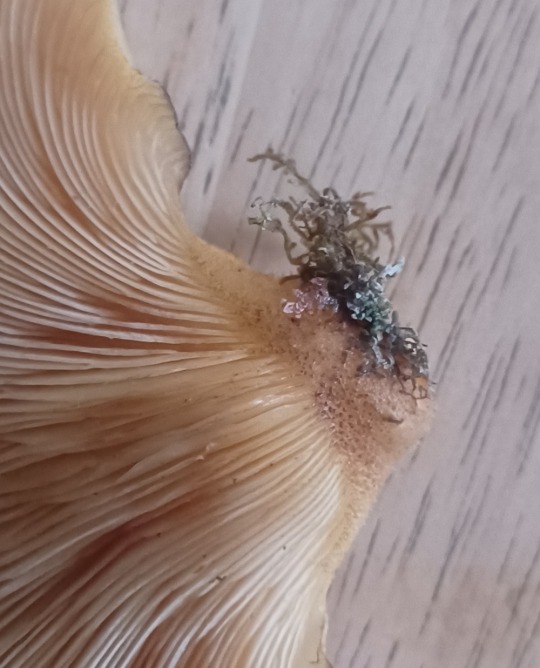
Notice the texturing on the stipe of this late oyster mushroom.
Like oyster mushrooms, late oysters grow in clusters on decaying hardwood trees, like maples and alders. They gain their “late” name for their tendency to fruit in fall to early winter; October to December is prime time for this fungus. Even in areas that receive frosts and freezes, the mushrooms may keep on growing in spite of the cold.
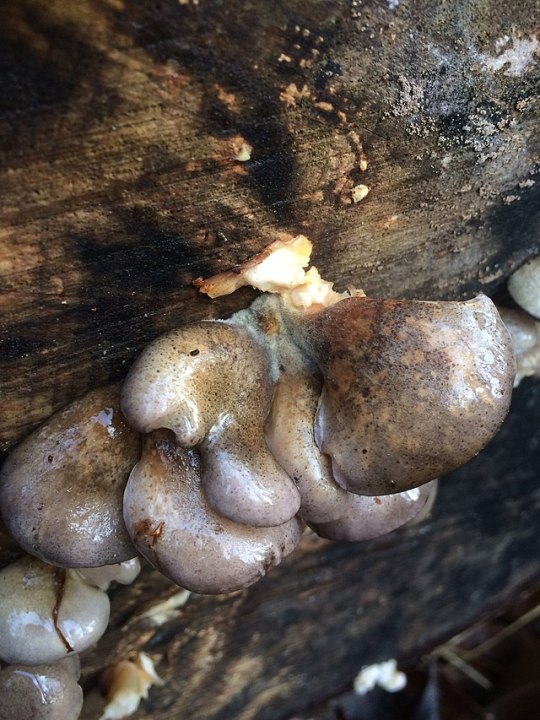
Other organisms it could be confused with and how to tell the difference: Again, true oyster mushrooms bear the most resemblance to late oysters. In addition to being less colorful–gray to white being most common–true oysters have a smooth rather than fuzzy stipe. Their spore print is usually white, occasionally with a slight purple tint. Finally, the gills of true oysters continue down the stipe (decurrent), while the late oyster’s gills stop at the stipe.
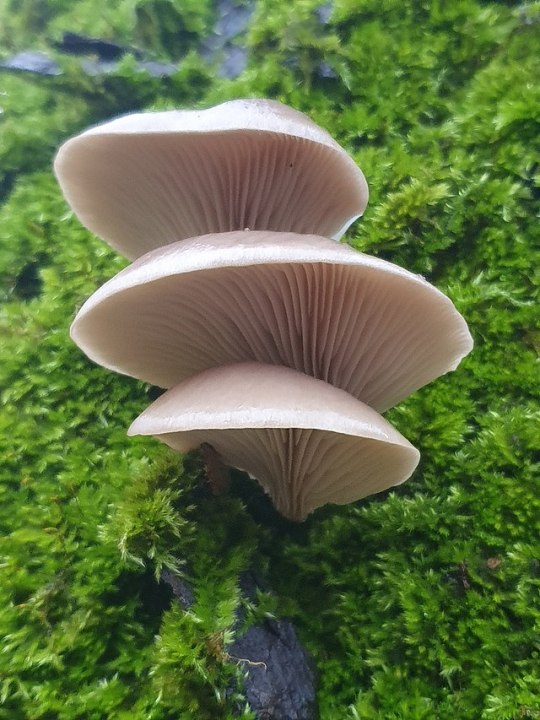
Oyster mushrooms (Pleurotus ostreatus)
Angel wing mushrooms (Pleurocybella porrigens) are another white mushroom found growing on dead wood. They lack the late oyster’s color variety and have decurrent gills that produce white spores, and their flesh tends to be more delicate. Most importantly, angel wings grow on decaying conifers while late oysters grow on hardwood trees, and they fruit in late summer into fall, but not to winter. Angel wing mushrooms used to be considered edible, but a series of poisonings several years ago has put their edibility into question.

Angel wing mushrooms (Pleurocybella porrigens)
Shoehorn oyster mushrooms (Hohenbuehelia petaloides) may sometimes look a bit like a brown-tinted late oyster mushrooms, but look underneath and you’ll see the white gills are decurrent, and they have a white spore print. Also, they tend to grow on woody debris rather than tree trunks, and will fruit anywhere from spring through fall.

Shoehorn oyster mushrooms (Hohenbuehelia petaloides)
The only other significant inedible lookalike besides angel wings is the mock oyster (Phyllotopsis nidulans). The orange cap may look similar to an orange-colored late oyster, but it has a fuzzy texture all over instead of only on the stipe. The gills produce orange to peach spores, are decurrent, and not as tightly packed as on the late oyster. A strong stench is the best way to identify the mock oyster, and should you try eating one it has an equally unappealing flavor and tough texture.
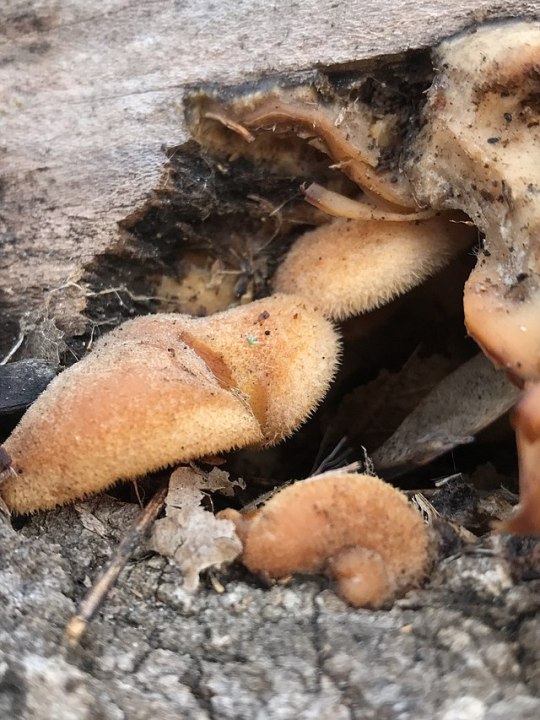
Mock oyster mushrooms (Phyllotopsis nidulans)
Anything else worth mentioning? Late oyster mushrooms are considered edible, though with a rather bland, unexciting flavor. Their texture is good, though, and they lend themselves well to being vehicles for sauces and other flavoring agents. Some people report they can be bitter if the top layer is not peeled off, and it is strongly recommended that they be cooked longer than some other mushrooms, at least 15-20 minutes. This can reduce the chance of gastrointestinal upset, but as always it is best to only try a very small amount of a new mushroom when eating it for the first time, and you MUST make absolutely sure you are 100% certain that what you are about to eat is an edible species.
Further reading:
Late Fall Oyster: Identification, Foraging, and Preparing
Late Fall Oyster Mushrooms: Sarcomyxa serotina
Late Fall Oyster (Panellus serotinus) — Identification & Medicinal Benefits
Late Fall Oyster: Sarcomyxa serotina
Did you enjoy this post? Consider taking one of my online foraging and natural history classes or hiring me for a guided nature tour, checking out my other articles, or picking up a paperback or ebook I’ve written! You can even buy me a coffee here!
#late oyster mushrooms#oyster mushrooms#edible mushrooms#edible fungi#foraging#mushroom foraging#mushroom hunting#shrooms#fungi#fungus#mycology#nature identification#nature#ecology#food#wild foods
18 notes
·
View notes
Text
i hate petalois i hate petaloids i hate petaloidsihatepetaloitsiha
18 notes
·
View notes
Note
4 status ailments 😱
( ˙▿˙ ) On de fifth day of winter, de labyrinth gave to me ~♫
(º □ º l|l) Fiiife F! O! EEEEEES!
4 status ailments, three petaloids, two cannon palms,
An a squirrel dat stole my warp wire! ~♪
2 notes
·
View notes
Text

Celt
Olmec
10th–4th century BCE
An Olmec sculptor created this celt, or axe, from a high-quality, blue-green jadeite. The petaloid (petal-shaped) celt was masterfully rounded and polished before likely being buried in a dedicatory assemblage. The color and shape of the stone, as well as the reference to a functional axe in this ceremonial object, reference maize agriculture. Jadeite celts symbolized sprouts of maize in Olmec imagery, concepts that were shared by societies in what is now Chiapas and Guatemala after about 1000 B.C. When “planted” in dedicatory caches, the makers of celts may have called for growth of their communities as they would hope for in a productive field of maize.
source
1 note
·
View note
Text

Dendrobium farmeri petaloid album sp.🥀
Is a dendrobium species orchid, the rarest of all den. farmeri forms as it is a petaloid/peloric White form, which are quite rare in nature, 7-8-inch long inflorescence arise from the nodes in spring
3 notes
·
View notes
Text

3 notes
·
View notes
Text
I really appreciate that EO2 had the first four Strata be based on seasons, and made the spring area the most dangerous.
In part because it and the Emerald Grove definitely set a precedent for what a First Stratum should look like, and partly because now everyone knows why Petaloids are to be feared.
...Except then Untold made them Forbidden Wood FOEs, but that really just goes to prove my point.
2 notes
·
View notes
Text
The Petaloid woodfrog, Rana petaloidoides, is a small-to-medium sized frog that reaches a maximum lenght of 3.5 inches. The native range of this beast reaches from south-East Asia to Northern Africa, where it can often be found sitting in well-watered flower beds. Unique to this species is it's distinct, petal-like patterning makes it a popular pet and exceptionally easy to ID in the field; making it a favourite among college students that don't feel like learning complicated ID charakteristics.
0 notes